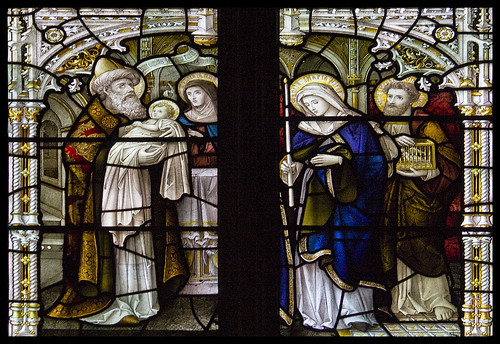I like to keep the old holidays. Well, some of them, anyway. I find old traditions fascinating, but I live in 2011, so whatever I chose to celebrate is through a modern filter.
Anyway, here’s what I know about Candlemas.
Some say the Christian observance of Candlemas originated with the notion that Mary was unclean for 40 days after giving birth to Jesus. She couldn’t take her baby boy to the temple until that 40 days was up. (If she’d had a girl it would have taken 60 days, which seems kind of sexist to me.) Thus it’s a feast of the Purification of the Blessed Virgin Mary, or the Feast of the Presentation of Jesus at the Temple.
But as with many old Christian holidays, there’s more to the story. After all, no one really thinks Jesus was born on the 25th of December. It just so happens that February 2nd is a cross-quarter day, midway between the solstice and the equinox. Thus it was regarded as the beginning of spring, and still is in Ireland.
As the beginning of spring, it was an auspicious time to predict the weather going forward. Here’s an old English poem.
If Candlemas Day is clear and bright,
winter will have another bite.
If Candlemas Day brings cloud and rain,
winter is gone and will not come again
Similarly, in Germany they had the tradition of the badger looking for his shadow. The badger was supplanted by the groundhog here in America.
The old Gaelic name for Candlemas is Imbolc, also know as St. Brigid’s Day or just Brigid. Apparently there’s a Christian Saint or an old Celtic goddess with the same name, and much confusion between the two.
It’s a fire festival, a day for making and burning candles. We’ll be burning that grass horsie Persephone made back on Lammas. She’s excited about it. We’ve had a candle-making kit for years, but I don’t think I’m quite ready to take that on.
Once upon a time, Candlemas was regarded as the absolute end of the Christmas season. I know, I know, it’s hard to believe, but in old times we didn’t have a “shopping season.” In my Grandpa Rudy’s childhood, decorations went up on Christmas Eve, after the kids went to bed; he didn’t even see the Christmas tree until Christmas morning. Epiphany (Twelfth Night) celebrated the arrival of the Three Wise Men, so they’d be added to nativity scenes at that time.
In Mexico, it’s still traditional to celebrate Three King’s Day (aka Twelfth Night, aka Epiphany) with a cake that has a baby baked inside. (Sound familiar?) Whoever got the slice with the baby would have to throw a party on — you guessed it — Candlemas.
Candlemas was the day decorations had to be put away, or bad things could happen. (Yes, yes, I know, some say Twelfth Night is the time. I say, push back against this insidious creeping of the calendar.) Here’s a Candlemas poem by Robert Herrick from the mid-17th century:
Down with the rosemary, and so
Down with the bays and mistletoe;
Down with the holly, ivy, all
Wherewith ye deck’s the Christmas hall;
That so the superstitious find
Not one least branch there left behind:
For look! How many leaves there be
Neglected there, Maids, trust to me,
So many goblins you shall see.
See? Goblins! So beware, and Happy Candlemas and Hail Brigid!
The beautiful stained glass is from Downside Abbey. Photo by Br Lawrence Lew, O.P., licensed under Creative Commons

The concept behind the mother being “impure” longer after the birth of a girl is that she is also “carrying” the “tumah” for the girl child who has just been born; both of them are life givers/carriers and have just safely negotiated the perilous path close to potential death in childbirth.
Wow, a post from Jerusalem? Thanks for the elucidation.
Hey, how about some pancakes?
http://www.theworldwidegourmet.com/traditions/candlemas/
Candlemas…..a beautiful word.
I heartily recommend making candles with your daughter. One of my nicest nursery school memories was the day we made candles — the basic kind, where you dip a long wick into melted wax, then into a bucket of cold water, then back into the wax, etc. until you have a candle-ish looking thing.
thank you for linking groundhogs day back to its origins.
………………If Candlemas Day is clear and bright,
winter will have another bite.
If Candlemas Day brings cloud and rain,
winter is gone and will not come again…………….
i have never heard this story before.
have you heard about any pagen rituals that are similar and linked to this day?
[…] Happy Candlemas I like to keep the old holidays. Well, some of them, anyway. I find old traditions fascinating, but I live in 2011, so whatever I chose to celebrate is through a modern filter. […]
Rick, if you’re talking about modern (neo) pagans, you should know that this day is celebrated as one of the eight Sabbats in the Wheel of the Year. Wiccans generally call it by the Gaelic name of Imbolc, but it also goes by Imbolg or Oimelc. Also St Brigid’s Day.
got my homework.
thanks.
never thought about someone as a neo pagan.
it makes perfect sense.
: )